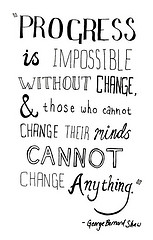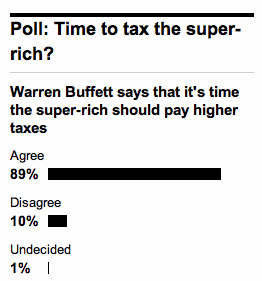|
|
|
Archive for the 'Change' Category
Tuesday, January 13th, 2015
 Dozens of ugly stories in 2014 threw a spotlight on the lack of gender and color diversity and the prevalence of bigoted and frat house/misogynistic cultures in tech. Dozens of ugly stories in 2014 threw a spotlight on the lack of gender and color diversity and the prevalence of bigoted and frat house/misogynistic cultures in tech.
Individuals and companies are speaking out vowing to change things — talking, talking, talking.
Intel, however, isn’t talking; it’s putting its money where its mouth is.
Intel said it has established a $300 million fund to be used in the next three years to improve the diversity of the company’s work force [goal of 14%], attract more women and minorities to the technology field and make the industry more hospitable to them once they get there.
The big difference between what Intel is doing and the rest of tech is not just focusing on STEM training and recruitment, but on changing the workplace so that those who join tech will stay in tech instead of being driven out by the current culture.
Changing culture is difficult within a company, let alone within an entire industry.
Google is already working on it, while most companies are suggesting/funding issues that are external, such as education.
Hopefully, the clout and funds that Intel is bringing to the table will makes a difference.
Image credit: Intel Free Press
Posted in Change, Culture, Ducks In A Row | No Comments »
Monday, May 5th, 2014
 A few months ago I read the book, Our Final Invention: Artificial Intelligence and the End of the Human Era by James Barrat. It was a tremendously interesting book and confirmed many of the concerns I’ve been having about my own industry for some time. Subsequently there have been a slate of articles wondering about AI and how the industry is progressing. A few months ago I read the book, Our Final Invention: Artificial Intelligence and the End of the Human Era by James Barrat. It was a tremendously interesting book and confirmed many of the concerns I’ve been having about my own industry for some time. Subsequently there have been a slate of articles wondering about AI and how the industry is progressing.
One of the book’s premises was that we need to take a step back and think about the moral and ethical basis of what we’re doing and how and what we’re imparting to these machines.
I believe that it will be difficult, or impossible, for the AI industry to change direction mid-streams and start being concerned about morality and ethics. Most of the funding for AI comes from DARPA and other such institutions that are part of the military and affiliated organizations. Finance is second largest funding source.
Most of the people who are concerned about AI (including James Barrat) worry about when machines gain human level intelligence. I am much more concerned about what happens before that. Today it is said that the most sophisticated AI has the intelligence of a cockroach. This is no small feat, but it also brings with it some clear implications – cockroaches have important drives and instincts that guide their behavior. Survival, resource acquisition, reproduction, etc. are all things that cockroaches do. How far away are we from when our AI exhibit these characteristics? What about when we get to rat-level intelligence?
At that point machines will be very powerful and control many of the essential functions of society. Imagine a frightened rat (or 6 month old toddler) with infinite power – what actions would they take to protect themselves or get what they perceive they want or need? How would they react if we stood in their way? How concerned would they be with the consequences of their actions? Most adults don’t do this today.
Before we achieve human level intelligence in machines, we’ll have to deal with less intelligent and probably more dangerous and powerful entities. More dangerous because they will not have the knowledge or processing power to think of consequences, and also because they will be controlling our cars, airplanes, electricity grids, public transportation and many other systems.
Most AI optimists ignore the dangerous “lower mammal, toddler and childhood” stages of AI development and only see the potential benefits at the end. But we need to think about the path there and what we can do to prepare as individuals and as a society.
Not to speak about the fact that once we reach human level intelligence in AI, we’ll be dealing with an intelligence that is so alien to anything we know (after all, we have lots of experience with cockroaches, rats and toddlers), and no way of knowing what its motives are. But that will be left for another discussion.
Posted in Change, Culture | No Comments »
Monday, April 21st, 2014
 I get it. I get what’s going on in terms of women in the workplace is news. I get it. I get what’s going on in terms of women in the workplace is news.
I get it that it is important to remind people that for all the progress that’s been made some things haven’t changed.
It’s still assumed that it’s OK to ask professional women, such as lawyers and marketing execs, to do stuff that would never be asked of the men in the organization.
“…plan parties, order food, take notes in meetings and join thankless committees…bring cupcakes for a colleague’s birthday, order sandwiches for office lunches and answer phones”
By the same token, it’s news that board diversity is moving at glacial speed, primarily because boards only want people with experience and to have experience they need to serve on a board.
“Recruiting women and minorities to boards is being slowed because of boards’ unwillingness to look at candidates who have not yet served on boards,” said Ron Lumbra, co-leader of the CEO and board services practice for Russell Reynolds. “There’s a premium on experience.’’
So while I have no problem with these subjects being presented over and over in the news, there is one thing I don’t understand.
Why are so many people surprised by the information?
Is the general population so naïve that they actually believe women are no longer asked to do tasks that are closer to house work than business work?
Do they really believe that the lack of board diversity is a function of the lack of experience as opposed a desire to spend time with people like themselves who are well within their comfort zones?
The sad part is that while it’s still news, it’s certainly not a surprise.
Flickr image credit: Arya Ziai
Posted in Change | No Comments »
Wednesday, April 16th, 2014

Personally, I think the only thing dumber than expecting a twenty-something to design a product that resonates with Boomers (the people with money) is to have predominantly men leading, guiding and driving innovation for a corporation whose customer base is 83% female.
Yet, that is what was going on at Kimberly-Clark.
In fact, the situation was dire enough in 2009 that it even caught the eye of the board.
If they wanted to create better products targeted to female shoppers, executives realized, they had to transform into the kind of company that propelled women into higher positions instead of letting their careers stall.
With consultants’ assistance, the company did a wide-ranging survey of what was holding women back.
These ranged from concerns that promotions would lead to putting their families second to eradicating the “mommy track” stigma to the time to commute in China.
Kimberly has moved aggressively to address the roadblocks and has accomplished a great deal over the intervening five years.
By 2013, women at Kimberly-Clark made up 26% of the director-level or higher slots, up from 19% in 2009. Female representation on the board of directors also increased.
That was enough to win Catalyst Inc.’s top award for advancing women in the workplace.
Of course, the prime question is did it pay off in terms that Wall Street could understand?
At the end of 2009, the company’s stock price stood at $63.71. By the end of 2013, it had risen to $104.46.
‘Nuff said; money talks.
Flickr image credit: Kimberly-Clark
Posted in Change, Culture, Innovation | No Comments »
Thursday, February 27th, 2014

I’ve worked with hundreds of bosses and entrepreneurs over the years and there are two concepts I do my best to indoctrinate them with.
The first is a basic principle without which you can’t lead.
- Leadership outside-the-box starts inside your head.
The second is a corollary and acts as a guide anytime change is necessary.
- To change what they do, change how you think.
The point is that every boss in every organization at every level will lead/manage based on the way they think, what they think, how they think, and what they believe.
In other words, they will be guided by their MAP.
So if a boss wants her people to think/act/do things differently, then the way to accomplish that is for the boss to change first.
Flickr image credit: svilen001
Posted in Change, Entrepreneurs, Personal Growth | No Comments »
Wednesday, February 26th, 2014

Cut through all the noise about how fast the world is changing, how to stay competitive, constant learning, retraining, etc. and one message comes through loud and clear.
Whatever the entity or organization he/she/it needs to know how to transform in order to stay relevant.
Transformation is a must whether you’re a bookstore or an author who believes there’s a need for them.
A men’s retailer, a woman’s or the mannequin supplier dealing with human non-uniformity.
Or a record store.
Not just relevant, but happy.
A person growing or a person doing a 180 pivot.
Whether entity or organization transformation is accomplished by changing MAP (mindset, attitude philosophy™).
But transformation itself starts by choosing to do it.
Flickr image credit: DaveHuth
Posted in Change, Personal Growth | No Comments »
Friday, February 21st, 2014
A Friday series exploring Startups and the people who make them go. Read all If the Shoe Fits posts here

Passion is good.
But passion unchecked yields freely to fanaticism.
Fanaticism paves the road to a closed mind.
Fanaticism in business leads directly to ‘not invented here’ syndrome.
Software giant SAP is known for its passion; not for its ability to play well with others, especially startups.
An attitude that is coming home to roost and motivating co-founder Hasso Plattner to change.
It was “jealousy,” he said, and a “not-invented-here” mentality. “We always worked with other companies, but when they did not do exactly what we wanted them to do, then we developed all kinds of animosities.”
Now, the growing popularity of HANA, SAP’s new database, along with realization that the world has changed is driving change at the software giant.
Along with the normal things large corporations do to connect with startup—venture arm, pitching forums, hacking contests—Plattner is opening a 24-hour café complete with food, coffee, alcohol and even stand-up comedy.
“You know University Drive … the main drag … in Palo Alto [Calif.]? We have acquired a nice location there and we will open the HANA Cafe by [our tech conference] Sapphire, so in three months.
“… We created it for these [startup] companies. They can come in. They can connect there. We’ll have all the electronic connections to 1,250 companies in the world. They want to have contact to Beijing, they can. … Startup companies can collaborate there. … This is what we want to support.”
SAP plans two more, in Berlin and Shanghai, all running 24 hours a day and fully connected.
New world. New product. New attitude.
The results won’t be in for months, but if stogy SAP does change it will be proof positive that any company can.
In the meantime you have a great, new place to work and hangout.
Image credit: HikingArtist
Posted in Change, If the Shoe Fits | No Comments »
Wednesday, February 5th, 2014

There’s been a social media firestorm since Tom Perkins had his say in defense of the so-called 1%.
I asked a retired serial entrepreneur who was funded by KPCB decades ago when the names on the door were actually working partners what he thought.
Tom was reasonably liberal when he was running KP. Many VC’s who had made tons of dough became very conservative as they aged, supporting right wing Republican and Libertarian causes. They seemed to regard it as an insult that the government was trying to take even a tiny smidgeon of their billions in taxes.
I get why Perkins comments incited so much noise, both sincere and politically correct, but the real story a few days earlier didn’t get the play it deserved.
Here’s the headline that should have gotten more attention.
World’s richest 85 people have as much as bottom half the population
This means the world’s poorest 3,550,000,000 (3.55 billion) people must live on what the richest 85 possess.
The statistics are from non-profit Oxfam and are neither political nor partisan—they just are.
Nor are they an indictment of the US, since they are global.
In line with the mantra of “think globally, act locally” what can you do to help change this?
KG Charles-Harris says,
“It’s really action in the little ways that makes a difference. Not everyone has to do big things, but small things are possible every day with little cost.”
Here are some ideas,
- Choose your role models more carefully; Richard Branson, Bill Gates and, more recently Mark Zukerberg are all in the 85%, but they model their lives very differently from Larry Ellison or the Koch Brothers.
- Commit to giving one week’s worth of what you normally spend on coffee to a cause you care about.
- Do the same with the time you save.
I’ll end by borrowing a line from a 1971 Alka-Seltzer® ad, “Try it, you’ll like it.”
Flickr image credit: playerx
Posted in Change, Culture, Leadership | No Comments »
Wednesday, January 22nd, 2014
I am truly tired of listening to the likes of Marissa Mayer and Sheryl Sandberg talk abut women in the workplace when, in fact, their world bears no relationship to the majority of women locally or globally.
Elite women, like their male counterparts, marry later and have fewer children than their less-educated sisters. They take shorter breaks from paid full-time employment (a reverse from past trends) and claim an ever greater share of overall female income while relying on nannies and other household help.
Also, I’ve always doubted that having hot women wearing minimal outfits as a booth attraction at tradeshows gives a company an edge. And guess what? It doesn’t.
Booth babes do NOT convert. How do I know? Well, I actually split-tested this a few years ago and the results were indisputable. If you have invested in a trade show to generate new business, using booth babes is a lead conversion boat anchor. –Spencer Chen, marketing professional
Interesting research from Harvard Business School Senior Lecturer Jill J. Avery focuses on the effect female cooties have on masculine brands. Who knew that masculinity was so very fragile?
“Gender contamination occurs when one gender is using a brand as a symbol of their masculinity or femininity, and the incursion of the other gender into the brand threatens that… Girls and women seem to have more freedom to consume products and brands commonly associated with the other gender than boys and men, who are more tightly constrained by the prevailing views of masculinity that associate being masculine with avoiding anything feminine.“
Then there’s the ongoing problem of women in STEM—or the lack of them, actually.
There is a lot of systemic bias in the system against young women taking this kind of direction with their studies and their career. And we must change that bias and it must be changed at the middle school level.
While many recognize that solutions need to be applied in middle school or sooner, new research shows that just having a male teacher may impede progress and intimidate interest.
The stereotype that men are better at math than women is so ingrained in our culture that women feel stereotype threat — and as a result, perform more poorly in math — just from watching a man take a dominant role in a math study group.
IBM is one company that is actively fighting back.
Women have played a key role in some of the most important innovations in IBM’s history. Meet some of them through the Technologista series that celebrates some of these accomplishments.
I think my favorite pro STEM-for-girls is Debbie Sterling, who starts much earlier. She’s the entrepreneur who not only didn’t buy into the hype, but also created toys to combat it.
Who said girls want to dress in pink and play with dolls, especially when they could be building Rube Goldberg machines instead?
YouTube credit: GoldiBlox
Posted in Change, Culture, Personal Growth | 1 Comment »
Tuesday, December 17th, 2013

It’s almost 2014; a clean slate to do great stuff—but is it really?
Four years ago I identified one reason that change is so difficult, especially when it comes to tweaking/changing culture.
That reason is still with us and is just as much of a problem now as it was then, which means my post is as valid now as it was in 2009.
So, in the interests of a great 2014, here is a little bit of guidance on moving those changes along.
Ducks in a Row: Eliminating Cultural Stuff
I read a fascinating article today about Americans, their stuff and their penchant for storing it instead of getting rid of it.
“The US has 2.3 billion square feet of self-storage space. (The Self Storage Association notes that, with more than seven square feet for every man, woman and child, it’s now “physically possible that every American could stand — all at the same time — under the total canopy of self-storage roofing. …one out of every 10 households in the country rents a unit…”
According to Derek Naylor, president of the consultant group Storage Marketing Solutions, “Human laziness has always been a big friend of self-storage operators, because once they’re in, nobody likes to spend all day moving their stuff out of storage. As long as they can afford it, and feel psychologically that they can afford it, they’ll leave that stuff in there forever.”
I’ve said for years that people aren’t water faucets, able to turn off emotions and thoughts or change their MAP just because they change environments from home to work or vice versa.
Reading the article made me realize a hidden reason that makes changing culture so difficult.
It’s not just that the parts of the culture changes, but that the employees won’t let go of the parts that are changing or being replaced; instead they store them away to sort later.
But later never comes, so, like the stuff in the storage units, it sits in the back of their minds running up a bill that is paid in energy, focus and productivity.
As a result of the economy, many of the thousands of storage units that were in use for no other reason than laziness are being cleared out, or at least downsized, and the stuff gotten rid of.
Perhaps this is a good time to work with your employees to clean out their mental storage places; to purge the cultural residue and clutter that fills them up.
So clear out the rubbish, open the windows and let the fresh air flow through reenergizing everyone.
I’m not saying that change is easy, but I hope this bit of insight will help you fulfill your 2014 vision.
Flickr image credit: Guy Renard
Posted in Change, Culture, Ducks In A Row | No Comments »
|
 Subscribe to
Subscribe to
MAPping Company Success
About Miki 
Clarify your exec summary, website, etc.
Have a quick question or just want to chat? Feel free to write or call me at 360.335.8054
The 12 Ingredients of a Fillable Req
CheatSheet for InterviewERS
CheatSheet for InterviewEEs™
Give your mind a rest. Here are 4 quick ways to get rid of kinks, break a logjam or juice your creativity!
Creative mousing
Bubblewrap!
Animal innovation
Brain teaser
The latest disaster is here at home; donate to the East Coast recovery efforts now!
Text REDCROSS to 90999 to make a $10 donation or call 00.733.2767. $10 really really does make a difference and you'll never miss it.
And always donate what you can whenever you can
The following accept cash and in-kind donations: Doctors Without Borders, UNICEF, Red Cross, World Food Program, Save the Children
*/
?>About Miki
About KG
Clarify your exec summary, website, marketing collateral, etc.
Have a question or just want to chat @ no cost? Feel free to write
Download useful assistance now.
Entrepreneurs face difficulties that are hard for most people to imagine, let alone understand. You can find anonymous help and connections that do understand at 7 cups of tea.
Crises never end.
$10 really does make a difference and you’ll never miss it,
while $10 a month has exponential power.
Always donate what you can whenever you can.
The following accept cash and in-kind donations:
|
 Dozens of ugly stories in 2014 threw a spotlight on the lack of gender and color diversity and the prevalence of bigoted and frat house/misogynistic cultures in tech.
Dozens of ugly stories in 2014 threw a spotlight on the lack of gender and color diversity and the prevalence of bigoted and frat house/misogynistic cultures in tech.



 A few months ago I read the book,
A few months ago I read the book,  I get it. I get what’s going on in terms of women in the workplace is news.
I get it. I get what’s going on in terms of women in the workplace is news.





